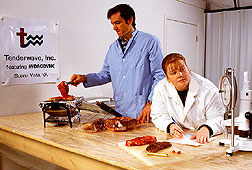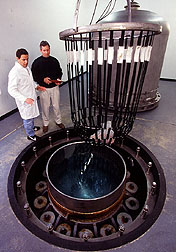Hydrodyne Exploding Meat Tenderness
In 1992, Morse Solomon, a meat scientist, joined forces with engineer John Long to test Long's invention, an innovative process called Hydrodyne, which uses shock waves in water to tenderize meat.
Solomon is with USDA's Agricultural Research Service, and Long is retired from the Lawrence Livermore National Laboratory in San Francisco, California. Early tests looked promising, but Long and Solomon needed to take the tests to the next level.
They needed someone willing to take risks. And this person had to believe in Hydrodyne's potential.
In Virginia, they found Eric Staton, who was with a company called Air Power, Inc. He was licensed and trained to use explosives, the agent that would create the shock waves in the process.
Staton helped Solomon and Long safely test the Hydrodyne concept using very small quantities of explosives and individual cuts of meat, such as steaks and small roasts.
Originally, in 1992, the process used an ordinary plastic drum filled with water and fitted with a steel plate at the bottom to reflect shock waves from an explosion. Yet, this crude device showed tremendous potential to safely tenderize meat.
Through the U.S. Department of Energy, Long and Solomon received an energy-related invention grant from the National Institute of Standards & Technology. A California company, Allied Engineering, built the first commercial prototype in Alameda. After completion, it was agreed that the Hydrodyne unit would be moved to Buena Vista, Virginia, Staton's home town.
Today's Hydrodyne uses a 280-gallon tank designed to tenderize 30 packaged subprimal beef cuts weighing more than 20 pounds each. There are about 10 subprimal cuts per steer.
The 36-year-old Staton, no longer with Air Power, Inc., is now a Hydrodyne entrepreneur--president of Tenderwave, Inc. He expects Hydrodyne to create about 100 new jobs around Buena Vista, where poultry is a big part of the economy.
"What first sold me on the project was Morse's extensive knowledge of meat science and muscle biology--and his and Long's enthusiasm," says Staton. "Then I went to a meat industry conference in San Antonio, Texas. When I saw how well the technology was received by the meat processors, I made up my mind."
|
|
"The Hydrodyne process could be used by companies that sell meat to hotels, restaurants, and supermarkets," Solomon explains. "It could give top-quality tenderness to lower grade cuts."
Currently, ranchers and farmers earn more money for beef with extra marbling fat interwoven within the lean muscle tissue. Marbling increases meat's tenderness, flavor, and juiciness, but excess fat in the human diet may pose a health risk.
Some high-end beef retailers "age" the top-quality cuts in a carefully controlled, refrigerated environment. This dry-aging breaks down muscle proteins, increasing tenderness but it's expensive, because of lengthy storage time and weight loss during aging. Dry-aged steaks rarely make an appearance outside of star-quality restaurants.
The Hydrodyne process could become the great equalizer giving tenderness to less-marbled, budget-grade meat. It would benefit consumers by giving them a product that is not only tender, but lower in fat, as well.
A Peacetime Use for Explosives
Throughout John Long's career as a mechanical engineer, he worked with explosives at Lawrence Livermore. His mission: preparing the Nation's defense. He always wondered if the explosives he studied could be used for peaceful ends--like tenderizing meat. Then, after more than 10 years of retirement and long after the Cold War's end, he began pursuing the Hydrodyne concept in earnest.
But he needed someone who could evaluate the technology from a meat industry perspective. Enter Morse Solomon. The two began preliminary work in 1992 and signed a formal cooperative research and development agreement in 1993.
"Morse evaluated the meat we tested with the original prototype," says Long. "He told me meat industry people usually get excited when they hear about a 40-percent improvement in tenderness. But he was measuring 50- to 72-percent tenderness improvements with Hydrodyne. Solomon was so impressed, he rechecked the results three times before he became a believer.
The Big Whammy
Visitors at the Hydrodyne plant can't see meat as it's being tenderized.
|
|
First of all, the 7,000-pound steel tank where the meat, water, and explosive are placed is covered with an 8-foot, 5,000-pound steel dome. The tank is embedded 10 feet in the ground. The dome is needed because when the tenderizing charge goes off about 2 feet from the meat, it generates enough force to push the water out of the tank and into the dome. The meat is first packaged to protect it from absorbing water and foreign contaminants.
Visitors also can't see the supersonic shock waves from the exploded charge travel through the water and tear certain muscle proteins in the meat.
Though they pass through water and meat, the shock waves bounce off anything that does not match the acoustic density of the water, such as the steel sides of the Hydrodyne tank. As the shock waves rebound off the tank wall, they intersect, compounding the force. Total forces can reach as high as 40,000 pounds per square inch. Yet, when done correctly, tenderizing by Hydrodyne doesn't damage or discolor meat. The technique also appears to work evenly throughout an entire piece.
So 600 pounds of subprimal cuts of untenderized, deboned beef get tenderized very quickly--within a few thousandths of a second. The same is true for poultry, pork, lamb, and other meats.
Cooked Hydrodyne-tenderized steaks were rated by a panel of testers trained by ARS food scientist Brad Berry. This panel ranked Hydrodyne's effects on the tenderness of Select-grade cuts, which are less tender than the two top grades of beef, Prime and Choice.
The panel ranked the meat for tenderness, flavor, and juiciness using sensory evaluation guidelines developed by the American Meat Science Association. They gave Hydrodyne high marks.
On the eight-point tenderness scale, Hydrodyne-processed Select steaks averaged a seven, a full point higher than untenderized Select steaks. The scores for Hydrodyne steaks were equivalent to top-quality Prime steaks in tenderness.
And the studies by the Beltsville scientists did more than just evaluate the technology's tenderizing potential. Solomon has more recently found that Hydrodyne may kill bacteria, thus making meat safer.--By Jill Lee, Agricultural Research Service Information Staff.
Morse B. Solomon and Bradford W. Berry are in the USDA-ARS Meat Science Research Laboratory, Bldg. 201, 10300 Baltimore Ave., Beltsville, MD 20705-2350; fax (301) 504-8438.
[Solomon] phone (301) 504-8463. [Berry] phone (301) 504-8994.
"Hydrodyne Exploding Meat Tenderness" was published in the June 1998 issue of Agricultural Research magazine. Click here to see this issue's table of contents.









